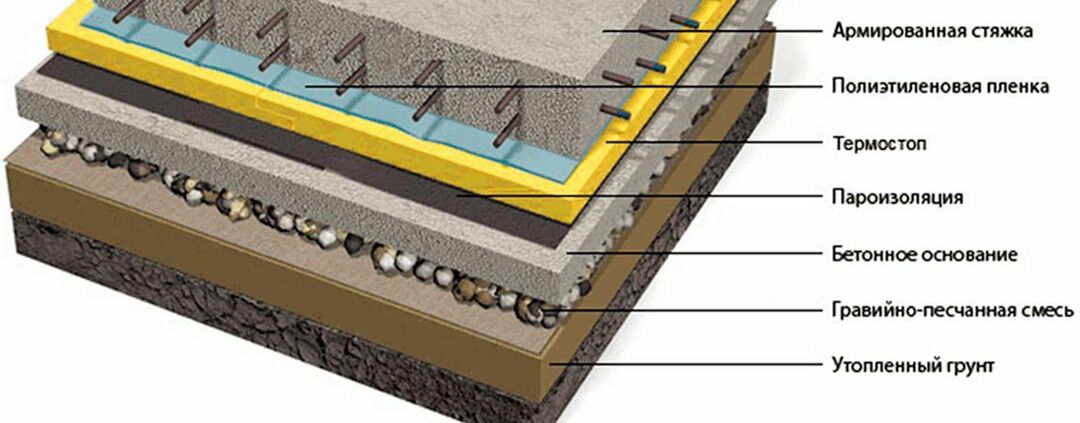Of all the possible problems with heating systems, this is perhaps the most difficult. And it's not even about why the underfloor heating does not work. There may be several reasons, but they can be established by enumerating and checking all possible options.
More unpleasant is the fact that malfunctions can be directly related to the heating film or cable hidden under the floor covering or filled with adhesive screed under the tile.
The content of the article:
-
Why the underfloor heating does not work - the main reasons
- Initial installation problem
- Lack of power
- Damage to the underfloor heating system
- Failure of the thermostat
- Damage and check of the temperature sensor
- Damage to the heating cable and heating mat
- Cable burning and signal generator
- Breakage of the heating cable core
Why the underfloor heating does not work - the main reasons
Diagnosing a water heater is easier. If the heating boiler is working properly, the valves and taps are normally closed, then the place of damage must be sought at the point where the warm part of the floor ends and the cold, unheated part begins. In the worst case, the problem can be found by leaking from a pipe and a spreading wet spot.
In a situation with an electric underfloor heating, the process of detecting a breakdown is complicated by the presence of a large number of components, each of which can potentially cause a circuit break.
Lots of options:
- The human factor is a violation of the underfloor heating assembly technology.
- Defects in the thermostat.
- Lack of contact in couplings or terminal blocks.
- Wrong wiring connection.
- Mechanical damage to the conductors of the heating cable.
The situation is simplified if a high-quality cable or graphite film was originally purchased. At the same time, the laying of the heating base was carried out by the master, and not by a self-taught amateur. In this case, the reasons for the non-working underfloor heating should be sought in the thermostat - check the contacts and the current voltage on the cable.
Initial installation problem
There are two basic electric floor heating schemes, depending on the heating element used. The first option is a canvas in the form of a graphite film applied to a vinyl base. Two copper conductors are printed along the edges of the strip, connected to an external power supply unit with a thermostat. When voltage is applied to the electrodes, heat is generated.
The second option is a high-resistance cable, poured under the screed.
In the process of working with a heating film, it is important to correctly lay thermal insulation with a reflective layer under it, and a laminate substrate on top of the heater. Thanks to the aluminum coating of the thermal insulation, all heat is reflected upwards.
If, during the installation process, the layers are mixed up, then the warm floor will not work. More precisely, there will be a feeling that it does not work, since all the heat will be redirected down into the concrete base.
The second reason why the underfloor heating may not work is the incorrect or unclear connection of the connectors to the contact tracks on the film. In the process of laying cords from the film mat to the power supply and thermostat, the terminal may break. Often the heater stops working if the laying of laminate, parquet, tiles was done carelessly.
Usually, when laying lamellas, the master periodically checks whether the warm floor is working, or if a break has occurred.
Exactly the same problems happen with cable underfloor heating. For example, the cable can be laid not on holders or a polyethylene mat, but simply on concrete, even without thermal insulation. In such a situation, there will be a feeling that the system is working, but the lion's share of the heat goes inside, into the concrete slab.

Cable underfloor heating may not work due to improper crimping of connectors (connecting chips). The worst case is if the contractor or worker mixed up the scheme and brand of cable, for example, he took the wiring for a single-core one, and laid a two-core one on the floor, and vice versa. For both cases, the symptoms of the "disease" will be the same. But the reasons why floor heating does not work are completely different.
Lack of power
One of the most common reasons why underfloor heating can be unstable or not function at all. In this case, the heating (if it works) will be uniform.
The warm floor may not periodically heat up and just as unexpectedly restore its work.
Similar symptoms indicate unstable power or poor contact on the terminal blocks. If the warm floor stops working (turns off by itself) synchronously with the indicator on the thermostat or power supply, then the matter is most likely in the cord or socket.
Check sequence:
- We check the voltage of the outlet network with a multimeter. To make sure that the underfloor heating might not work due to the plug or contacts, you can use a network extension cord (carrying) through which to connect the system to an outlet on another branch of the wiring.
- If the mains voltage is normal, then plug the power cord into the outlet and make sure that there is supply voltage at the contacts of the block, which is plugged into the socket on the power supply.
- If the problem is not found, then you need to check with a multimeter the presence of operating voltage at the input of the thermostat, on the output cable of the unit.
In 80% of cases, the reason for the lack of power is the wiring junction box, socket or plug, cord. The remaining 10% are in situations where the connection of the underfloor heating to the network is not planned correctly.
For example, another powerful consumer of electricity (a washing machine) is connected to one branch of the electrical wiring. When turned on at the same time, the mains voltage will drop below the working limit, and the floor will stop working.
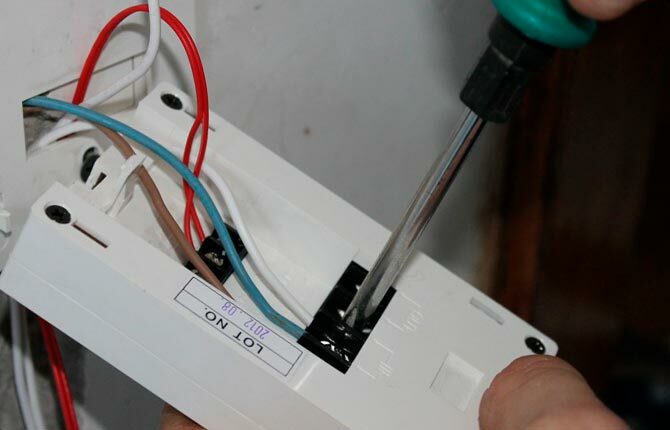
Damage to the underfloor heating system
The most difficult is the situation when individual parts or elements of the heating base are destroyed. For example, a film underfloor heating may stop working after an unsuccessful rearrangement of furniture, or if the laminate was laid without compensation gaps around the perimeter.
In theory, even too much deflection of the plywood or chipboard board of the rough base can violate the integrity of the contact paths of the film heater.
Often, after removing the laminate and the substrate, it turns out that the warm floor does not work due to a break in one of the contact tracks. In this case, you have to cut off the non-working part and lay a new canvas, connecting to the rest with the help of "crocodiles".
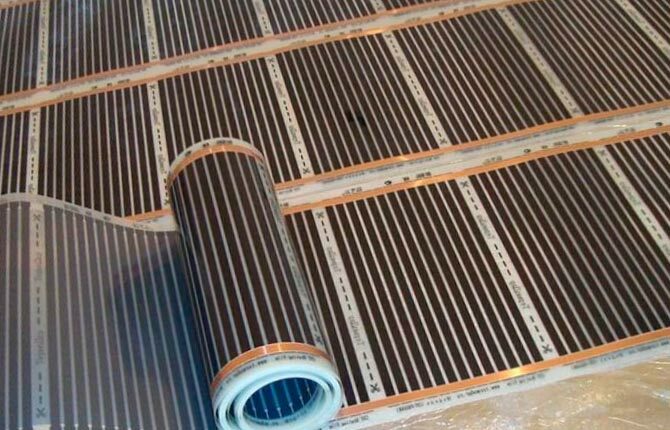
Damage to the cable heater is less common, mainly due to careless handling of the cable. The main reason why a cable underfloor heating may not work is a broken wire or a short circuit in the wires.
Failure of the thermostat
The device that controls and controls the heating process can be made on a different element base. But most inexpensive thermostats are assembled approximately according to the scheme below.

The most important parts, due to the breakdown of which the heating does not work:
- thermistor (R9);
- triac (VS1);
- zener diode (VD3).
The combustion of any of the listed elements leads to the fact that the thermostat either does not work, or incorrectly regulates the level of heating of the warm floor. To check the parts, you need to desolder the part and check it with a multimeter.
Thermostat circuits may differ, but not by much. Usually most of them work on the same principle. Programmable and wireless controller models are more likely to fail due to power surges. As a result, the warm floor will not work due to the failure of some capacitor at the input.
The design also has a variable resistance R5, with which the heating level of the warm floor is set. If you often adjust - rotate the potentiometer, then over time the graphite track inside the part may simply be erased.
In a worn regulator, the contact will periodically disappear or jam in one place. The warm floor will work, but at one certain power level. In any case, you will have to disassemble the box to understand why the heating level adjustment does not work.
It may happen that there is no thermostat circuit, and besides, not all models (especially Chinese ones) can be soldered and repaired. The best way is to replace the thermostat with the same device. It may not be new, the main thing is that it is obviously serviceable. If the procedure did not give anything, and the floor did not start working, then, apparently, the reason is not in the thermostat.
The performance of the thermostat can be checked by connecting an ordinary 150 W incandescent lamp to the output terminals (instead of the heating section of the cable). If turning the knob changes the heat of the spiral, then everything is fine with the regulator, and the floor does not work for another reason.
For reinsurance, you need to check correct wiring connection to the terminals on the thermostat or terminal box. See if there are any burnt contacts, and if all fixing screws are tightened to the stop.
In older models of underfloor heating, mechanical thermostats with a bimetallic temperature sensor mounted inside can be used. These devices practically do not break, but are very sensitive to dust. A common situation is when the underfloor heating does not work after repairs in the apartment due to dusting of the contact, because construction dust acts as an insulator and blocks the contacts.
Damage and check of the temperature sensor
Almost all modern floor heating models use a remote sensor with a negative temperature coefficient (NTC type). This means that as the temperature rises, the internal resistance of the thermistor decreases, and as it decreases, it increases.
For branded models, the sensor in the thermostat circuit is protected, so a break in the contact on the thermistor causes the floor to operate at maximum power or turn off completely.
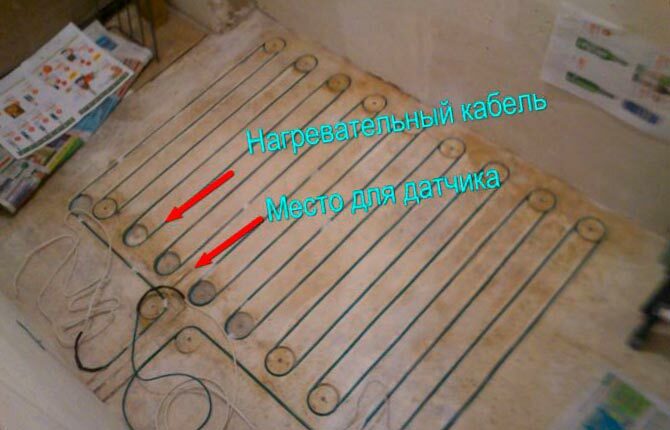
In relatively inexpensive and home-made models of underfloor heating, for example, with a thermostat assembled according to the above diagram, the sensor is unprotected, and a broken contact can lead to a strong heating of the warm gender.
For a cable system, this is not so scary, especially since most underfloor heating is tiled. Dried up, and work on. But for a graphite film, the consequences can be unpleasant. The heater can be deformed, and it is not known how long the entire heating system will work.
Check work temperature sensor You can use a multimeter on a heated floor. To do this, de-energize the thermostat and cable. Next, on the junction box, disconnect the thermistor contacts and connect the multimeter probes in the resistance measurement mode. As long as the floor is warm, the resistance should be low enough. As it cools, the readings on the meter should increase.
You can simply ring a new temperature sensor with a multimeter by measuring the internal resistance. On a working cold thermistor, the device will show 20-45 kOhm.
If you connect the probes of the device to the sensor contacts, and then hold it in your fist for several minutes, then the resistance will drop to 6-7 kOhm. Just in case, you need to clarify in the documentation the maximum and minimum resistance for a particular model of temperature sensor.
They try to put the temperature sensor as close as possible to the plane of the heating mat. To increase the sensitivity, the thermistor is placed without a cover, only the contacts at the soldering site remain closed.
Often the sensor is simply displaced and comes into contact with the cable sheath. In this case, information about the heating level is overestimated, so the warm floor works inefficiently - it heats up to a maximum of 25 aboutFROM.
The thermostats of most modern models use a built-in indication of the sensor operation (green-red LED). While the temperature sensor is working, the green light is on, if it does not work, it is red. This allows you to quickly take action to eliminate problems until the cable heating system has melted the mat substrate.
Damage to the heating cable and heating mat
The underfloor heating cable system can be single-core or two-core. In the first case, there is one high-resistance core inside the cable, and the supply voltage is supplied to the ends of the segment using additional copper wires. They don't get hot and are easy to replace when needed. The connection is made with crimp sleeves.
The cable may not work only if the contact under the sleeve is broken or due to an internal break in the core. For example, if a cold wire from frost is strongly bent with a loop.
In a two-core cable, two cores are insulated, so heating sections or mats are always made of a fixed length, for a certain thermal power and current consumption. A pair of stripped contacts is connected to the terminal box, a jumper is soldered from the opposite end of the wire.
The most common type of damage to a two-core heating wire is damage to the internal insulation between the cores or to the outer sheath on the side of one of the conductors.
In the first case, it is possible to diagnose damage to a warm floor only by uneven heating of the floor covering. The part of the floor adjacent to the thermostat will overheat greatly, the rest of the surface will not warm up well or remain cold. A warm floor will not work for a long time in this mode, it is possible that the insulation and even the substrate panel will melt.
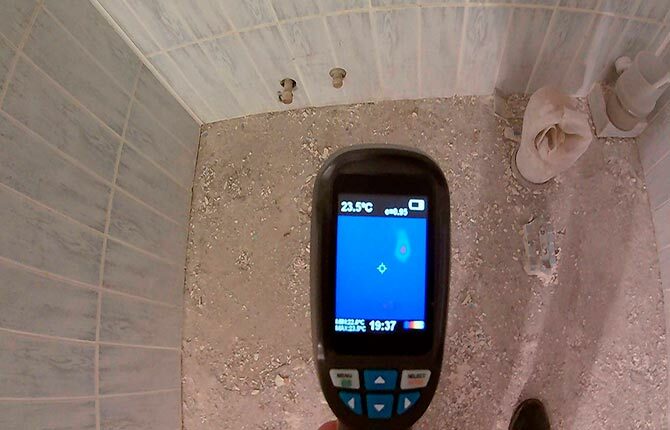
You can find the short circuit using a remote IR thermometer, you just need to find the hottest spot on the floor. If the laying scheme remains, then the location of the circuit on the warm floor can be calculated by measuring the resistance of the closed cold cable.
You need to make a measurement by first disconnecting the cable from the thermostat. Knowing the resistance of a good and closed wire, it is possible to calculate the length of the heating section using the formula for parallel conductors.
Cable burning and signal generator
The low level of heat output given out by a warm floor with the regulator set to maximum indicates the presence of an unstable contact at the junction between the main thread of a single-core cable and an additional copper wire.
If you use a multimeter signal generator and ring the circuit for an open, then the device will most likely show a normal contact. As soon as the thermostat turns on the heating, the warm floor will start to give out heat, but, not having time to warm up to the operating temperature, it stops working.
The essence of the problem is that the two ends of the core at the point of the break diverge when heated, although in the cold state they can touch each other.
You can fix the problem by burning the circuit. For this, a magneto from a two-stroke scooter engine or an HDTV with a scanner from an old TV (tube) can be used. Magneto is considered the safer option, although not the best solution, it almost always works.
Before burning, turn off all electrical appliances from the outlet, the thermostat should work. We connect the wires from the magneto to the contacts on the cable and use an electric drill (screwdriver) to spin the generator shaft for a few seconds. The ends of the cores at the point of uncertain contact must be welded.
The warm floor may not work due to water entering the junction of the cores. In this case, neither magneto nor HDTV can be used categorically. Previously, the cable will need to be connected to a low-voltage (20-25 V) source of pulsed current and the conductor must be heated in short pulses for several hours.
Breakage of the heating cable core
Violation of the integrity of a high-resistance conductor is considered a severe type of damage. The underfloor heating does not work and does not even start. It is possible to eliminate the gap only by opening the base and sealing the place of the break.
You can determine the point of destruction of the heating wire with a special cable tester or with the help of an oscilloscope, by changing the capacitance - inductance of a two-core cable. But this should be done by a specialist.
It is not so difficult to establish the reasons why the underfloor heating does not work. Before inviting the wizard, draw up a diagram of all possible options for yourself and sequentially check the performance of the heating circuit nodes.
Tell us about your experience in diagnosing and repairing underfloor heating - how difficult was it to determine the cause, and how was the performance of the cable heater restored? Bookmark this article so you don't lose it.


